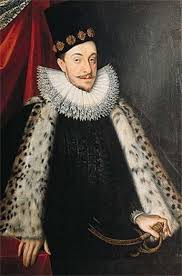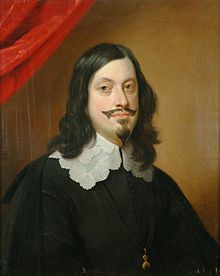Alright, back to updating. This update will be the beginning of a series of posts dedicated to the series of Swedish Monarchs who ruled during the stormaktstiden: the Swedish Empire. This was a time in which the Baltic Sea was a Swedish lake in all but name, and the monarch being covered in this update is widely seen as the one who set the stage for the Swedish imperial period.
Naming
With the name ‘Gustavus Adolphus’ you would be forgiven for assuming we were discussing a Roman general or Emperor rather than a Swedish king. His Swedish monarchial name was Gustav II Adolf, and the fact that he is widely known by the latinized form should be a testament to the glory that he covered himself in over the course of his lifetime. However, if it doesn’t, then some of the other titles he had amassed might do the trick: The Lion of the North, the Golden King and even the ephitet “The Great”; a title which has not been granted to any other Swedish monarch up to the present day.
Early Life and Dynastic troubles
Gustavus Adolphus was born in Stockholm on the 9th of December 1594, the eldest son of Duke Charles, soon to be Charles IX of Sweden. He was born in a time of turmoil: the ruling King of Sweden at the time was Gustavus’s cousin Sigismund, who was also King of Poland-Lithuania and-crucially-a staunch Catholic. This was fine for the mainly Catholic Poles and Lithuanians, but for the devoutly Protestant Swedes having a Catholic monarch ruling them from Warsaw was not an attractive prospect; Sigismund’s blatantly Pro-Catholic agenda in Sweden alienated many Swedes and gave Duke Charles the perfect opportunity to gain the Swedish crown he so coveted. In the teeth of opposition from much of the Swedish nobility, Charles declared war on Sigismund, and despite certain setbacks he was successfully crowned King of Sweden in 1604. Sigismund never gave up on his ambition to reclaim his Swedish crown, and the feud between the two branches of House Vasa would be part of Gustavus’s inheritance when he ascended to his father’s throne in 1611.
Rule as King
The Lion of the North.
Gustavus inherited more than just a Kingdom when he was crowned King at the age of 16. By 1611 Sweden was at war on several fronts: the Ingrian War against the Russians in the East and the Kalmar war against the Danes in Southern Sweden. By 1614 he had managed to end both of these wars-victoriously against the Russians, less so against the Danes-and was able to commit himself to gaining experience of peace-time ruling. The Swedish nobility had lost much of their power during the reign of Charles IX, so when their young king ascended, they sensed an opportunity to reclaim much of that power. To that end, the Swedish privy council-the Riksrad-forced Gustavus to sign the Accession Charter in January 1611, in which he pledged to consult them in all his policies and appoint only members of the high nobility to high positions in the government. However, the Swedish nobility never managed to obtain complete dominance over the crown, and throughout Gustavus’s reign the crown and nobility would enjoy a fairly balanced, harmonious relationship. The Swedish Parliament, known as the Riksdag, fully supported the King during his later campaigns, and this provided him with a free hand to pursue his European ambitions.
War with Sigismund
Sigismund III Vasa, whose desire for the Swedish throne would cause wars during and beyond his own lifetime.
In 1625, the 31-year-old Gustavus began a war with the Polish-Lithuanian Commonwealth. His forces invaded Livonia and Prussia(basically Latvia, Lithuania and north-east Poland), and over the course of four years his forces enjoyed mixed success, with the capture of several towns and fortresses mitigated by several defeats in the field by Hetman Stanislaw Koniecpolski, whose brilliance was in large part the only reason why the inefficient Commonwealth army was able to operate on the scale needed to defeat Sweden in the field. By 1629, the Poles were actually in a relatively strong position, having just won a victory over the Swedes at Hoingfield in which Gustavus himself was nearly killed, but Sigismund refused to settle for anything less than the reclamation of his Swedish crown. That was not forthcoming, and the Truce of Altmark was weighted in Sweden’s favour. In it, they gained tax rights on Polish goods and were given much of Polish Livonia as well as cities in Prussia. Crucially, they also received the vital Baltic port of Riga(the capital of modern-day Latvia) which gave Sweden a serious advantage in the Baltic Sea trade.
Upgrading the Military
What Gustavus Adolphus is truly famous for is his military innovations which allowed the Swedish army to completely turn the tide of the religious wars in Europe. European armies of the time were generally disjointed creatures: the cavalry-who formed the elite of the army-often fought their own independent battles with enemy cavalry, leaving them isolated from the other elements of the army. When they did fight, they would generally charge, fire their weapons, then retreat to reload and reform, before charging again. This was not a particularly useful method, as the lack of shock value in the charge resulted in cavalry often being little more than mounted infantry. The Infantry of the time were the lowest rung of the army, and generally fought in tightly packed formations pioneered by the Spanish, who invented the Tercio formation that all armies based their infantry formations on. They used square formations with musketeers and pikemen mixed in: the musketeers would exchange fire with the enemy, while the pikemen would serve as anti-cavalry forces. The problem here was that by Gustavus’s time some of these formations were massive-some up to 50 ranks deep. This made them clunky in inefficient, highly vulnerable to more maneuverable enemies. As for the artillery, they were mostly siege units, but when they were used in open battle they were also a fairly independent unit; cooperation between the three elements of an army was not a widespread tactic during this time. Gustavus pioneered combined arms tactics. All of his soldiers were cross trained-infantry could operate cannons and ride horses, while cavalry could dismount and fight as infantrymen for example-and the tactics of the different units changed as well. He re-introduced melee weapons to cavalry, and trained them to combine pistol firepower with cold steel to maximize the shock value of his cavalry. Standard issue muskets were introduced to the Infantry, and their formations were significantly shallower than the average formations in Europe at the time to maximize the firepower of his units. As for the artillery, their number increased significantly, and light mobile artillery became a key element in the Swedish army as a way of further increasing the firepower of his army. These innovations gave the Swedish army a significant advantage over their enemies in terms of sheer attacking power and flexibility, which would play out during his war in Germany.
Intervention in Germany and death
The Protestant Reformation had caused turmoil in many countries, but for the fractured Holy Roman Empire, it would signal a near century of strife. From 1618, the Empire-most of which was composed of modern-day Germany-had been in civil war over the status of the Protestant states in an Empire ruled by the Catholic Habsburgs. And by 1630, their status was a poor one indeed. Catholic armies had defeated Protestant armies in Bohemia(modern-day Czech Republic) and Brandenburg(north-east Germany), and had beaten back an attempt by Denmark to intervene on their behalf. The Edict of Restitution seemed to be paving the way for the full Catholicization of the Empire, and the Spanish and Imperial troops were on the verge of complete victory.
Ferdinand III, Holy Roman Emperor who fought Gustavus Adolphus.
For Gustavus, this was intolerable. Catholic domination of the Empire would leave the south coast of the Baltic under their control-and would put Catholic armies practically on Sweden’s doorstep. For the Swedes, only a secure, Protestant northern Germany could keep Sweden safe. Therefore, in June 1630 Gustavus landed in Pomerania on the north German coast with the first soldiers from his army and prepared to fight. This was complicated by the fact that several Protestant princes-particularly those of Brandenburg and Saxony-were almost as wary of Swedish domination as that of the Habsburgs, and were reluctant to commit any forces to his cause. Despite this, Gustavus-with a new model army and French subsidies in his pocket-managed to bring the main Imperial army to battle in 1631 at Breitenfield in Saxony, which had been invaded by Imperial forces under the Count of Tilly. The new Swedish tactics proved utterly devastating to the Imperials. By the time the Swedes won the day, Imperial casualties had reached 27,000 total and Tilly himself was wounded. By contrast, Gustavus must have been on cloud nine. Breitenfield was a turning point in history. In a single stroke, German Protestantism had been rescued from the brink of possible destruction, Swedish power and influence had risen to unprecedented heights and the balance of power in Europe had been fundamentally altered. Even after Gustavus’s death, the renewed Protestant armies would force the Catholics to a compromise settlement rather than the absolute victory they had been on the cusp of in 1629-30. Following Breitenfield, more Protestant states joined the Swedish cause and French financing increased substantially, leaving Sweden and Gustavus Adolphus the virtual ruler of Protestant Germany. However, this new alliance was fragile, and in order to maintain and possibly even craft the Protestant alliance into a lasting union, Swedish armies needed to keep winning victories, and this was complicated by the appearance of Albrecht von Wallenstein. Wallenstein was-to be succinct-the best general the Catholic side had, but his ambition was there for all to see and the Emperor had fired him, seeing him(probably correctly) as a threat. However, with Tilly badly wounded(the 72-year-old general would be killed in battle six months after Breienfield) there was no alternative, and the Emperor tasked him with rebuilding the Imperial army, which he did in record time.
Albrecht von Wallenstein, whose forces would be the end of the legendary Swedish monarch.
In 1632, Gustavus invaded Bavaria in southern Germany, while Saxon forces invaded Bohemia He once again defeated Tilly at the Battle of Lech-fatally wounding him in the process-and captured Munich, the Bavarian capital. Wallenstein advanced north, driving the Saxon army out of Prague and invading Saxony itself, capturing Leipzig-the Saxon capital-and camping at Lutzen to draw Gustavus north and stop his attempted march on Vienna, the imperial capital. It worked. Gustavus attempted a surprise attack on Wallenstein’s strong defensive positions, but Wallenstein was ready and a full-scale battle erupted. During this battle, Gustavus-who had been personally leading a cavalry charge-was separated from the main cavalry force and killed in the confusion. Despite this, the Swedes won the battle and forced Wallenstein to retreat back into Bohemia, but the loss of Gustavus Adolphus left the victory a hollow one at best. Without his strength of character and authority to bind the Protestants together, the Swedish position in Germany was permanently weakened, and Sweden would never again be able to effectively rule Germany as he had. However, he left Sweden with an improved military and a strong diplomatic position in Europe, which would be used by his successors to dominate the Baltic for the remainder of the 17th century.




